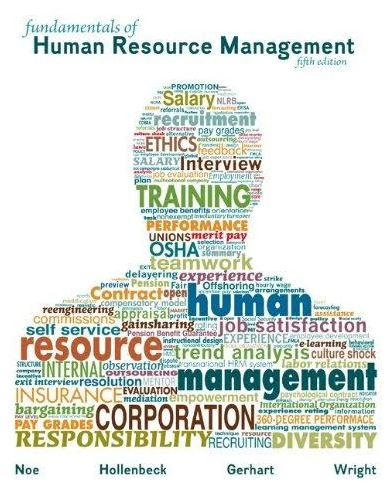
Fundamentals of Human Resource Management 5th Edition by Raymond Noe, John Hollenbeck, Barry Gerhart, Patrick Wright
Edition 5ISBN: 9780077515522
Fundamentals of Human Resource Management 5th Edition by Raymond Noe, John Hollenbeck, Barry Gerhart, Patrick Wright
Edition 5ISBN: 9780077515522 Exercise 19
Paying More, Getting Less
Today's computing power lets employers crunch data about employees and their performance to find patterns that can help them make better predictions. In the academic world, researchers also are analyzing business data to detect patterns that may apply beyond a single organization. For example, at the University of Pennsylvania, Matthew Bidwell analyzed six years' worth of data from an investment bank to look for patterns in the pay and performance of its employees.
Bidwell found an unfavorable pattern in the bank's hiring and pay practices: When the organization brought in an outside person to fill a vacant position, it paid 18% to 20% more than when it filled a position internally (through a promotion or transfer). But compared with internal hires for that type of position, external hires got significantly lower performance evaluations during their first two years on the job. Furthermore, the external hires were 61% more likely to leave involuntarily and 21% more likely to quit. Bidwell compared these results with pay and performance at another investment bank and at a publishing company, and he found similar patterns.
In an effort to explain the mismatch between performance and pay, Bidwell noted that the external hires tended to have more education and experience than employees who were promoted or transferred. Once on the job, they need time to build relationships within the organization, and this holds back their ability to perform well for the first couple of years. Even when jobs are filled by an internal hire, initial performance tends to suffer for a while if the person taking the job comes from a different department and therefore needs time to establish new working relationships.
Suppose that the bank Matthew Bidwell studied is setting up a DSS for employment decisions. In general terms, how should Bidwell's data analysis shape the results provided by the DSS?
Today's computing power lets employers crunch data about employees and their performance to find patterns that can help them make better predictions. In the academic world, researchers also are analyzing business data to detect patterns that may apply beyond a single organization. For example, at the University of Pennsylvania, Matthew Bidwell analyzed six years' worth of data from an investment bank to look for patterns in the pay and performance of its employees.
Bidwell found an unfavorable pattern in the bank's hiring and pay practices: When the organization brought in an outside person to fill a vacant position, it paid 18% to 20% more than when it filled a position internally (through a promotion or transfer). But compared with internal hires for that type of position, external hires got significantly lower performance evaluations during their first two years on the job. Furthermore, the external hires were 61% more likely to leave involuntarily and 21% more likely to quit. Bidwell compared these results with pay and performance at another investment bank and at a publishing company, and he found similar patterns.
In an effort to explain the mismatch between performance and pay, Bidwell noted that the external hires tended to have more education and experience than employees who were promoted or transferred. Once on the job, they need time to build relationships within the organization, and this holds back their ability to perform well for the first couple of years. Even when jobs are filled by an internal hire, initial performance tends to suffer for a while if the person taking the job comes from a different department and therefore needs time to establish new working relationships.
Suppose that the bank Matthew Bidwell studied is setting up a DSS for employment decisions. In general terms, how should Bidwell's data analysis shape the results provided by the DSS?
Explanation
DSS helps in solving the managerial prob...
Fundamentals of Human Resource Management 5th Edition by Raymond Noe, John Hollenbeck, Barry Gerhart, Patrick Wright
Why don’t you like this exercise?
Other Minimum 8 character and maximum 255 character
Character 255


